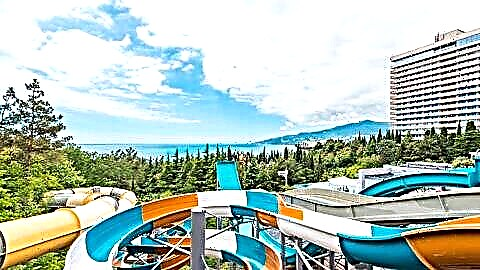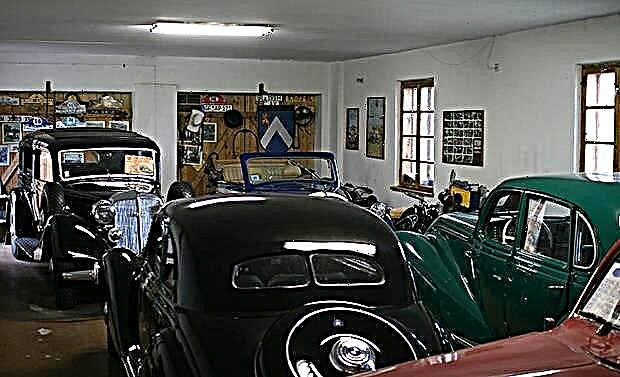Kostroma lands are often called the flax capital of Russia. They are also known for their highly developed meat and dairy farming, quality cheese and large forests. The territory of the region is one of the largest federal subjects that are part of the Central District of the country. Travelers come here to admire the architectural monuments of the "Golden Ring" of Russia, to visit the homeland of Ivan Susanin and A.N. Ostrovsky, and also drop in on a visit to the Snow Maiden.
Ancient towns of the Kostroma region
In the Kostroma region there are about 2.5 thousand monuments of architecture and history, and most of them are concentrated in cities. The most popular on tourist routes are Kostroma and the smaller historical towns of Nerekhta, Bui, Galich, Chukhloma, Makariev and Kologriv.

Paisievo-Galichsky Assumption Convent in the city of Galich
Galich was founded at the beginning of the XII century. This is one of the most ancient Russian cities that have survived to this day. The shopping arcade complex and the Paisievo-Galichsky Assumption Monastery became its visiting cards. There are several old Orthodox churches in Galich - the Vasilievsko-Vvedensky temple complex in Rybnaya Sloboda, the Church of Kosma and Damian, the Trinity Cathedral, left from the former Nicholas monastery, and the Epiphany temple.
The small, quiet and picturesque town of Bui appeared on the Kostroma lands in the first half of the 16th century. It is located about 100 km from Kostroma. Zheleznoborovskiy Forerunner Monastery is located near Buy. And in the town itself there are several old churches: the Annunciation Cathedral, the Church of the Resurrection of Christ and the St. Nicholas Church. In Bui it is interesting to look at the old merchant houses and the building of the former noble assembly.

Holy Forerunner Jacob-Zheleznoborovsky Monastery
In 1970, Kostroma Nerekhta was included in the list of cities in the "Small Golden Ring" of Russia. It stands on the Solonitsa River and attracts many travelers and pilgrims who want to see the shrines of the Trinity-Sypanov convent and ancient temples. Nerekhta is famous for its interesting local history museum and the interregional festival of sacred and folk music, which is held here in late spring. And in this small town beautiful knitted dolls and linen dolls are made. In addition, pottery has been preserved in Nerekhta, and local craftsmen delight guests with cute clay toys.

Trinity-Sypanov Pakhomievo-Nerekhta Convent
The city of Kologriv is located in the north-east of the region, 380 km from Kostroma. His chronicle dates back to the second half of the 18th century. Kologriv is often spoken of as the goose capital of Russia. Thousands of wild geese, making a spring flight from European countries to the Arctic tundra, stop every year right in the city limits, in the natural reserve "Kologrivskaya Poima". During the month, they rest and feed on the floodplain of the Unzha River. And the amazingly beautiful sight attracts many tourists, bird watchers and amateur photographers to the city of Kostroma. On the first weekend of May, a big holiday is even held here - "Goose Day", which gathers a lot of people.

Kologrivsky Museum of Local Lore named after G.A. Ladyzhensky
In Kologriv, the local history museum is popular, which is located in an old merchant mansion. The museum collection was founded by the artist G.A. Ladyzhensky and now bears his name. The works of famous Russian painters T.G. Shevchenko, I.N. Kramskoy, I.I. Shishkina, V.L. Borovikovsky, as well as paintings by Western European masters of the 16th-19th centuries. Among the architectural monuments in Kologriv, the Monastery of the Knyazhaya Pustyn, founded in the 15th century, the majestic Assumption Cathedral and the picturesque Church of the Savior Not Made by Hands, stand out.
Merchants and noble estates of the Kostroma region

Museum-reserve A. N. Ostrovsky "Shchelykovo"
In the Kostroma region, several old noble estates have survived, built mainly in the 19th century. The most popular among tourists is the Shchelykovo estate, which currently has the status of a memorial and natural museum-reserve. It is located 120 km from the regional capital and is associated with the life of the Russian writer A.N. Ostrovsky, as well as famous actors of the Maly Theater. Shchelykovo recreates the atmosphere of the life of the Russian nobility in the 19th century.
Recently, the restoration of the estate complex in the village of Dolmatovo, which belonged to A.P. Ermolov. And in Kostroma itself you can see two-story manor houses owned by the Arzhenikovs, Ashastins, Zotov, Gornyakovskaya, A.N. Ponizovsky, A.P. Durygin and A. Sovin.
Museums of the Kostroma region

Romanov Museum in Kostroma
In total, there are about three dozen museums in the region, most of which are located in Kostroma. This is the museum of nature, folk crafts "Petrovskaya toy", the museum of flax and birch bark, wooden architecture, jewelry art, watchtower and the museum of fire-fighting, the Museum "Les-Miracle", as well as the most famous - the Romanov Museum and the Museum "Noble Assembly". However, other cities and villages of the region keep interesting memorable collections.
In the village of Zavrazhie, the guests are hosted by the memorial museum of film director Andrei Tarkovsky and philosopher Pavel Florensky. In the village of Krasnoe there is a museum of jewelry and folk applied art. And in the village of Susanino there is a local history museum dedicated to the feat of Ivan Susanin, which is located in the building Church of the Resurrection - an architectural monument of the 17th century. This church is well known for the painting "The Rooks Have Arrived" by the Russian artist Alexei Savrasov.
Natural monuments of the Kostroma region

Resurrection Church in the village of Susanino. Shown in the painting by Alexei Savrasov "The Rooks Have Arrived".
The lands of the Kostroma region cover an area of just over 60 thousand square meters. km. and occupy a moraine-hilly, in places swampy, plain. 62% of the entire territory is covered with forests. These unique forests are included in the UNESCO World Heritage List and are among the 100 most valuable forests in Europe. And in the region, 53 reserves have been created and 18 unique natural monuments are protected.
A remarkable natural landmark - the territory where the European dark coniferous taiga is protected - is the large biosphere reserve "Kologrivsky forest". Interestingly, some of the local protected forest lands have never been affected by humans and have not been affected by fires, mainly due to the remoteness from the places where people live. Therefore, individual trees reach an age of 350-400 years and a height of 40-45 m. Such relict spruce forests do not exist anywhere else on the territory of the European part of Russia.

Church of the Epiphany in the village of Krasnoe-on-Volga
In the Sumarokovsky nature reserve (Krasnoselsky district), tourists love to visit the moose farm. Here, on an area of 200 hectares, since 1963, work has been carried out on the domestication of moose - a unique, only scientific experiment in the world. The farm is open to guests all year round. And on it you can not only see moose and take pictures with animals, but also taste nutritious moose milk.
What to see with children in the Kostroma region
The Kostroma region is considered the birthplace of an interesting pottery craft - the Petrovsky clay toy, which was founded in the 1970s. Children will love the whistles, which got their name from the village of Petrovskaya, located in the Susaninsky district.

In the Museum "Petrovskaya Toy" in Kostroma
In Kostroma, a special museum is dedicated to these toys, which is located at ul. Erokhova, 4. Greenish-brown clay crafts depict people, animals and birds, and whistles (ocarins) are distinguished by a strong, drawn-out sound.At the Petrovskaya Toy Museum, children can take part in master classes conducted by experienced pottery teachers and learn how to sculpt clay crafts on their own.
It is interesting to come to Kostroma with children for the New Year or Christmas, because this city is considered the birthplace of the Snow Maiden. Granddaughter of Santa Claus lives in a beautiful chopped Terem and receives guests with excursions every day (Lagernaya st., 38). Here children will find fairy tale characters, an extraordinary Ice Room and many interesting adventures. Fairy Terem is open not only in winter.

Terem of the Snow Maiden in Kostroma
The Snow Maiden and her assistants also meet guests during other national holidays: in February - on Maslenitsa, in early May - on Earth Day, and in mid-June - on Green Christmastide. And right on the embankment, not far from the monument to Ivan Susanin, there is a museum "Snegurochka's Fairy Land" (street 1 May 4/9).
Kostroma souvenirs
Traditional souvenirs that made Kostroma craftsmen famous far beyond the region's borders are linen and jewelry. Local linen products such as tablecloths, towels and clothing are very popular. They are strong, beautiful and durable. And all because the technology of cultivation and processing of flax has been perfected by the inhabitants of the region for centuries. They sell similar souvenirs at fairs and in Tkani stores.

Cathedral of the Nativity of the Blessed Virgin Mary in the town of Soligalich
Kostroma jewelry is also famous throughout Russia. Indeed, on the territory of the region there have always been from three to six specialized factories. The Kostroma Jewelry Factory has been operating in the regional capital since 1939 and produces the most modern jewelry products from gold, platinum and precious stones. Moreover, at affordable prices!
Another popular folk craft of the Kostroma people is birch bark weaving. His secrets are passed down from generation to generation. In memory of visiting the Kostroma lands, you can buy various birch bark crafts: hair clips, beautiful patterned boxes and boxes, photo frames and bracelets.

Cathedral of the Transfiguration in the village of Sudislavl
And lovers of delicious souvenirs will surely not remain indifferent to local dairy cheeses. No wonder the Kostroma cheese-making factories are considered one of the best in the country. These delicious souvenirs can be bought at grocery stores and markets. And in summer and early autumn - at the traditional Kostroma fair "Cheese Exchange", held in the center of the regional capital.











